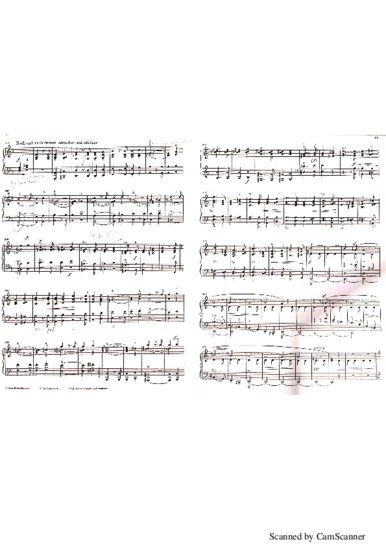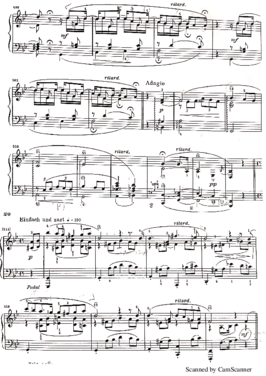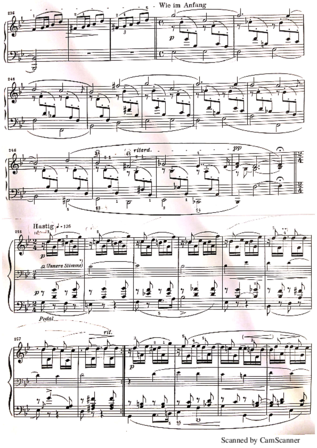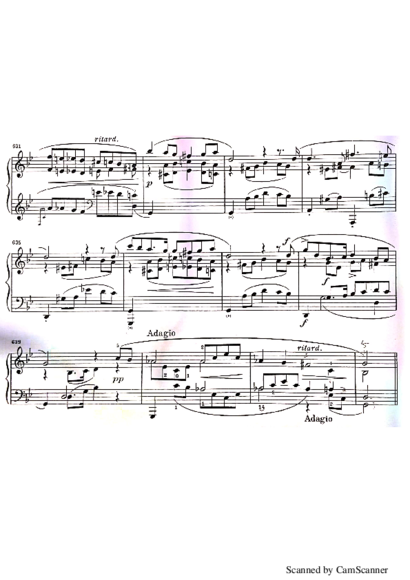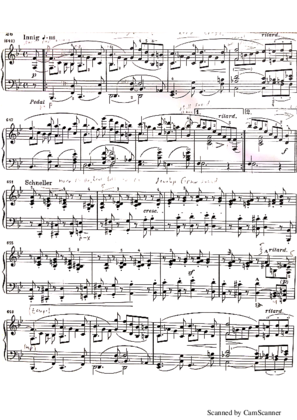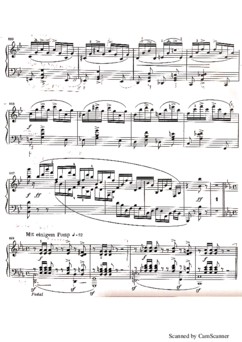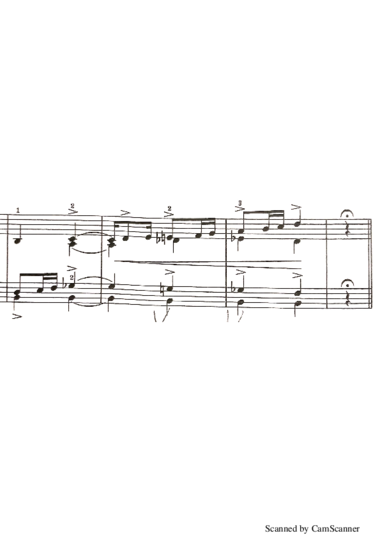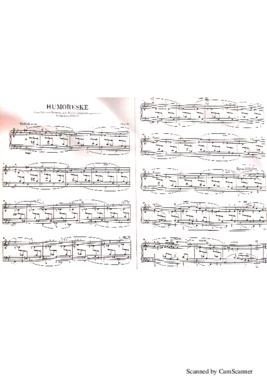Recording session 1:
Here I was working on the section marked "Nach und nach immer lebhafter und starker", bars 358-446 (see attached score extract). I excluded the 24 transitional bars at the end of the section and added the last 13 bars of the previous one.
This section begins abruptly and somewhat menacingly in the key of d minor, following a triumphant arrival at B-flat major. The obsessive dotted rhythm and accentuated downbeats imply that this is a kind of march; also, a canonic relationship is maintained between the upper and lower voice.
I feel a strong connection between this section and some form of romantic irony- it is apparently very serious and strict, but the sudden, radical change in musical mood that it engenders is almost too extreme to be taken seriously. Additionally, the way in which the canon is maintained in spite of all sorts of dissonances and harmonic ambiguities which it creates along the way, appears to me intentionally comical. Finally, Schumann's indication "to become livelier and stronger" implies an impatience, even a (mock?) passion which is at odds with the strict musical content.
Recording 1a: In this recording I tried to bring the irony of the section to the forefront, explicating it, as in what Jean Paul calls "whimsy". For this I decided to begin immediately after the previous section concludes, leaving almost no pause or separation- I thought this way the transition will be more shocking, allowing no time for the listener's mind to adjust. The other things that happened in this recording were spontaneous and unplanned: I delayed the downbeats slightly, exaggerating their heaviness (more so in the beginning); I played some accelerando, indeed getting more lively, but not in a continuous way- pulling back significantly when the whole progression repeats in a minor (bar 382).
Overall I wasn't entirely convinced by this effort- the almost caricature constant manipulation of timing does perhaps convey the idea, but it becomes tiring and repetitive and disrupts the natural flow of the music too badly. Maybe dynamics can be used more effectively?
Recording sesion 3:
Here I was again working on a transitional section, this time on the bars leading to the G minor "Ëinfach und Zart" (491/505-521)
rec. session 3a- In this recording I played the transition similarly to the way I play the previous one between sections 1 and 2: with a gradual "fade out" release of last chord, a long pause, and an uncertain tempo in the beginning of section 3, still "searching". I'm not convinced it works as well in this instance- as the ending of section 2 is extremely halting and uncertain (including 4 fermatas and 4 ritardandos in the last 15 bars!) perhaps the transition at least would benefit from being more straightforward.
rec. session 3b- here I played a more abrupt release of the last chord and a shorter pause, beginning the next section clearly in the new tempo. This works better in my opinion- section 3 being the most consistently "simple" and melodic of the work ("singing from the heart", earnest through and through), it benefits from being immediately characterized as such.
Also, this transition and the one before "Mit einigem pomp" are the only ones with a rest before the following section, implying that the previous chord shouldn't be too much prolonged (and therefore emphasized). There is also no fermata! The change occurs almost instantly, during the rest, emphasizing the contrast between the two sections. Perhaps what holds this transition together is the concealed A to B-flat which closes section 2 and then appears as the upbeat of section 3 (albeit already in the minor key, as we discover when the base G appears on the downbeat)
Recording 1b: This time I tried to convey the other, objective sort of irony by "imitating coldly and calmly the appearance of something serious". I made a more significant pause to begin the section and then played with almost no rubato, producing a more continuous accelerando and crescendo.
This version convinces me more- especially the transition and opening measures, where the stark, contrasting character is established immediately thanks to the more stable rhythm. Perhaps the "serious" aspects of the music here are too dominant to be downplayed into "whimsy", and the irony is best allowed to speak for itself? In any case, I have the impression that the general intensification of the music which Schumann indicates is key here- it should be produced in an even more obsessively stable manner.
Recording session 2:
Here I was working on the transition to the 2nd main section of the Humoreske(bars 238-258)
My instinctive association here is withe Jean Paul's concept of "empty conclusions". As happens in several transitional sections, the final few bars of section 1 (246-250) only weaken the sense of harmonic stability and "arrival", rather than strengthening it, so thanactually we feel quite lost here- although we have arrived at b-flat major, it hardly feels like the tonic. So at this point it is actually a complete mystery what is going to happen next, and even in what tonality the next section will begin. My aim is to find an appropriate timing for this connection, and the best quality of tone for the beginning of section 2- which is truly a dream within a dream; perhaps it shouldn't so much begin as materialize.
rec. 2a: Here I made a long pause for the transition, but the straightforward tone in the beginning of section 2 sounds strange when combined with a slow tempo and uncertain, "searching" quality of the rhythm.
rec. 2b: Here I try the opposite: a shorter pause (trying to maintain the tension) and an "emerging" quality to the tone (beginning very softly) but not to so much to the rhythm, as I settle very quickly into a more flowing tempo.
rec. 2c: close to 36 in the quality of the tone, but starting slightly slower and gaining momentum. This transition works best in my mind- a drawn fade-out througout the fermata and only the smallest fraction of complete silence. I should try not to lose the tempo after I have reached it. Also, when the opening repeats it should perhaps begin immediately in tempo.
Recording session 5:
"Schneller" section within "Innig", with transition (bars 643-660/662)
In these recordings I again experiment with forms of irony. The abrupt schange of tempo and the contrasting material of the "Schneller" are particularly shocking after the dreamy opening of "innig", providing something of a rude awakening. I find the contrast here to be even more extreme than the one at the previously discussed "Nach und nach immer lebhafter und starker", because in this case there is no rest or pause to separate the sections. Tellingly, even the ritardando, which appears in bar 650 before the repeat, is emitted the second time in order to avoid any ppossible reparation.
rec. 5a: a very capricious or "whimsical" reading. I begin the "Schneller" section quite slowly and make an accelerando, pulling back temporarily when the gesture repeats at bar 655.
rec. 5b: a "serious" ironic interpretation, with a clear closure in bar 650, beginning the Schneller immediately at a faster tempo and maintaining it throughout.
rec. 5c: something in between; less separation before the Schneller, beginning with some capricious rubato and then playing a steady and very slight accelerando throughout. I find this a good balance- the contrast inherent to the musical material is so extreme in itself that, while it shouldn't be played entirely seriously, by exaggerating it too much I would risk turning the section into a caricature.
Recording session 4:
In these recordings I was working on the ending of "Einfach und zart" (bars 632-642)
In this section I was particularly influenced by Jean Paul's idea about "empty conclusions"; the short Adagio coda can be seen as an excellent musical example for this- after we have already arrived at a final g-minor, it seems that the coda's main purpose is to weaken the sense of harmonic finality by inserting the neopolitan A-flat major (and barely resolving it in the last moment), while also making a vague comment on one of the themes of this section. This is something of an anti-climax for an extremely meaningful and expressive section of the work, and in the spirit of the time it could have definitley been considered to be "humorous".
rec. 4a: Here I tried to bring across the vagueness of the ending by continuing directly into it without separation and not taking the Adagio very literally, saving most of the ritardando for the very end. Also I try to be less outwardly expressive by minimizing the rubato.
rec. 4b: a different way to make this ending humorous in the romantic sense would be by contrasting it strongly with the material that comes before. In this recording I take a longer pause, even allowing for some silence before beginning the coda. I play the Adagio immediately in a slower tempo and hold a long pedal for a somewhat otherworldly effect. Fianlly, I try to play in an entirely objective, even expressionless manner by keeping a very stable rhythm for the continuous stream of 8th notes. In this case I hope that the expression is actually enhanced by the strakness of the playing and the immediate contrast in sound.
recording session 6:
Here I work on the ending of "Innig" (bars 679-692). This section connects again to the idea of "empty conclusions"- despite arriving at a B-flat base pedal point, the coda gives the feeling of a wandering instability. This may be due to the syncopated and highly chromatic nature of the upper voice, which reiterates the same questioning statement and obssesses over the motive of the rising semi-tone before arriving at a halting conclusion.
rec. 6a: in this recording the beginning of the coda does sound uncertain, searching.
This isn't bad, but perhaps it would work better if I emerge gradullay from the haze of sound, rather than doing this suddenly in bar 687? In other words, I should try to produce a gradual, almost unnoticeable accelerando e crescendo- this way I would sustain the surreal atmosphere of the coda, not 'leading' it to any particular moment.
Also, maybe the entire coda can be even more mysterious? I could achieve this by defining the top voice less clearly and playing the beginning even softer, with slightly blurry pedalling.
I try to make these changes in recording 6b
Recording session 7:
End of "Sehr lebhaft" and transition to "Mit einigem pomp" (bars 819-836).
After the triumphant ending of "Sehr lebhaft", the abrupt change in bar 833 is quite shocking. The title of the next section, which best translates to "somewhat pompously", can also suggest a certain irony or self-awareness.
rec. 7a: Here I played a long pause at the transition- as there is a one bar rest, this is quite natural.This way the victorious ending of "Sehr lebhaft" resonates for a long time (mentally, if not literally). Then I begin "Mit einigem pomp" with generous pedalling and a full, metalic sound.
In this recording I play both sections quite literally and "seriously", without exaggerating the contrast between them. Also, I don't try to bring out the ironic quality of "Mit einigem pomp", allowing the contrast to speak for itself.
rec. 7b: Also here, the rest between the sections plays an important part- except that this time it is cut a little short, making the triumph appear short lived and premature (or even imaginary?). Then, in "Mit einigem pomp", I use the third pedal in order to sustain the base notes while the upper-voice syncopated chords are cut short. This creates a strong, even absurd contrast between the resonance of the two sections. Also, the somewhat artificial effect created by the pedalling sounds to me more ironic. However, as preparation to the final episode of the work, a "lifting of the curtain" as it were, the section as a whole could benefit from the richer sound of the previous attempt.
Recording session 8:
Here I work on the opening of the Humoreske- "Einfach" (bars 1-36)
rec. 8a: intuitively played with a personal, subjective approach. The result is a rather slow tempo, playing every melodic note with utmost care for the tone as well as the sustained long line. What suffers here is the "Einfach", the simplicity suggested by Schumann. The effect of a simple tenderness is very hard to achieve.
rec. 8b: the idea of simplicity can also be associated with a form of objectivity. I tried to play the opening as though rather than being experienced, it is narrated. I'm not conviced that I really achieved this result, though this recording probably sounds somewhere in the middle: the tempo is slightly more flowing and the rubato less pronounced, so there is a little more simplicity here. However, the intenslely expressive nature of this music - as I experience it - makes it difficult to detach myself emotionally and maintain a narrative objectivity; this is true especially from bar 28 (marked "etwas lebhafter") where the music becomes increasingly agitated, though this section was perhaps intended to be played in a different character or perspective.
Recording session 9:
In these recordings I work on the transition at the end of "Sehr rasch und licht", before "Noch rascher" (bars 69-88).
Here Schumann employs a transitional motive which will also appear later in the 1st section of the Humoreske. The motive begins with an unexpected syncopatiotion and then rises quickly, before ending just as unpredictably; in both appearances it signifies an abrupt change in the music.
This motive can be seen as a musical representation of Jean Paul's principal of "humorous sensuousness", where he claims humor "should overflow with witty and imaginative contrasts". Whenever the motive appears, it seems as if Schumann is so inpired with fresh, contrasting musical ideas that he isn't capable of ending one section politely and beginning the next- Instead he uses the motive to interrupt the old and introduce the new.
rec. 9a: a literal approach to the motive, playing quite steadily and in rhythm, with an emphasized final chord. For me this isn't convincing- this transition is too unexpected to be played completely matter-of-fact. Perhaps the rest with the fermata at bar 80 can be emphasized.
rec. 9b: here I play an accelerando along with the cresceno of the rising motive, trying not to land too heavily on the last chord but rather play through it- leading to the rest and emphasizing it. This motive appears once more in the section and represents for me a capricious restlessness, a desire to move forward to a different place or musical scene. It has an unexpected urgency to it, and I think this "pull" requires some freedom and accelerando.
Recording session 10:
Working on the "Noch rascher" (bars 80-128~)
rec. 10a: In this recording I was influenced by one part of Jean Paul's definition of "wit"- the ability to recognize similarity between apparently unrelated concepts. The "Noch rascher" is quite is quite clearly divided into two sections, with the second, fanfare-like part beginning after the fermata in bar 104.
By playing the 8-notes starting from bar 88 increasingly marcato, I tried to prepare this change so that it seems to occurs naturally, rather than emphasizing the contrast. To this end I also minimized the fermata in bar 104 and didn't entirely lift the pedal before starting the fanfare. Additionally, I tried to keep the tempo in which I arrived at bar 104.
Perhaps, if I play these parts so continuously, it would be better to wait longer after the appearance of the transitional motive (before beginning bar 120). Otherwise the effect on the listener could become too breathless and dizzying- he could use another moment to orient himself.
rec. 10b: Here I tried doing the opposite- really relishing in the contrast provided at bar 104, making it more vivid and "humorous" in the romantic sense. I do this by somewhat under-playing the crescendo in bars 102-104, taking longer for the fermata and adding a cesura before starting the fanfare. Also I pull back the tempo for this part, leaving time to really hear every chord. I use the transtional motive and ensuing pause (bars 117-119) in order to return to tempo.
